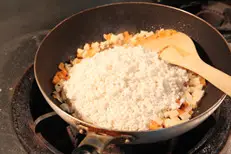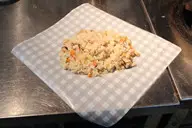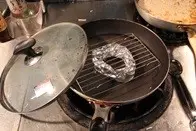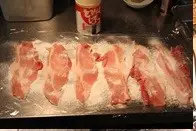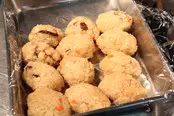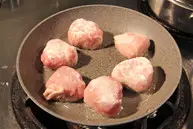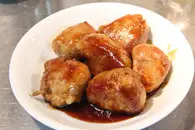Special Foods for Children's Day (Recipe Included)
- MAIDO
- May 2, 2024
- 7 min read

Kashiwa Mochi Rice Cake
Kashiwa mochi is a very common food for Children's Day. It is made by wrapping a mochi rice cake, which is considered a good luck charm, with a leaf of the kashiwa, oak tree in English, which is also considered a good luck charm.
The oak tree has long been considered a plant of good omen because its leaves do not fall off until the young shoots have grown up, thus wishing for the prosperity of offspring. The oak tree is not commonly found in western Japan, and the custom of eating Kashiwa Mochi on Children's Day spread mainly in the Kanto region from the Edo period (1603-1867).

We offer kashiwa mochi at our store along with some other mochi sweets - sakura mochi and uguisu mochi. They are seasonal items, so get them while you can!


Chimaki
Chimaki is a rice cake rolled with leaves of bamboo grass or cogon grass, etc. Chimaki is said to be a custom mainly in the Kansai region. Originally, the custom of eating Chimaki on Children's Day was introduced from China.
The strong fragrance of the leaves used to wrap the rice cake is believed to ward off evil. The threads used to wrap the rice cake are also meaningful, and the five colors of red, blue (or green), yellow, white, and black (or purple) are believed to have the same meaning of repelling evil spirits, just like koinobori's streamer we have introduced above. However, using the plain white thread is more common nowadays.

Chimaki is eaten in different ways depending on the region. Between Hokkaido and Kanto Koshin region, chimaki with okowa, a triangle-shaped Japanese steamed rice dish made with glutinous rice mixed with meat or vegetables (the first two photos in this chimaki section), is the mainstream, while in Kansai region, skinny sweet rice cake is inside (photo above this paragraph). They are usually wrapped in bamboo leaves. When you unwrap and eat them, you can smell the fresh aroma of bamboo leaves.
(Recipe) Chimaki Wrapped with Meat

This is not a recipe for traditional chimaki, but the one for that arranged to children's liking. It must be difficult for most of you to get bamboo leaves, mustn't it? You do not need to worry. You can roll it up with thinly sliced pork sold at Maido and eat it all as it is.
Ingredients (for 6 pieces):
1 cup of glutinous rice
1 oz./30 g of takenoko bamboo shoot
0.1 oz./3 g of dried shiitake mushrooms
0.7 oz./20 g of carrot
6 slices of pork
2.4 fl. oz./75 cc of water
katakuriko potato starch as needed
<for rice>
1 tbsp of cooking sake
1 tbsp of mirin
1 tbsp of soy sauce
1 tbsp of sugar
1 tbsp of sesame oil
<for meat>
2 tbsp of cooking sake
2 tbsp of mirin
2 tbsp of soy sauce
2 tbsp of sugar
1 tbsp of sesame oil
Directions:
1. Soak glutinous rice in water for at least 6 hours.
2. Cut the bamboo shoot, dried shiitake mushrooms, and carrot into cubes and fry them in 1 tablespoon of sesame oil. If you use the pre-cooked bamboo shoot, drain it well and mix in at the end.
3. When the oil has spread, add what you prepared in step 1 and fry slightly, then add 1 tablespoon each of water, sake, mirin, and soy sauce in that order and bring to a boil for 1 minute.
4. Spread a parchment sheet and wrap what you made in step 3 including the liquid.
5. Steam in a steamer (or a *pan steamer) for 15 minutes.
*It is easy, just make a base with aluminum foil and fill it with water.
6. Lay out the pork and sprinkle with potato starch.
7. Divide into 6 equal parts and roll up what you prepared in step 5 with the meat prepared in step 6. (In this photo, there are 12 pieces instead of 6.)
8. Put 1 tablespoon of sesame oil in a frying pan, add 6 pieces and cook on all sides.
9. When the color of the meat changes, add 2 tablespoons each of sake, mirin, sugar, and soy sauce in that order.
10. Cover the pan and cook for 2 minutes. Enjoy.
Tip: Even if you do not have a steamer, you can easily steam glutinous rice in a frying pan.

Chirashizushi
Chirashizushi is a standard meal for celebrations of any kinds in Japan with its gorgeous appearance. It is a festive “scattered” sushi rice prepared by Japanese home cooks with a beautiful medley of colorful toppings usually with some seafood, eggs, and vegetables. Some people believe that by eating foods from the sea and the mountains together, they can take in the power of nature's bounty while being grateful for its blessings.
You can put any ingredients of your favorite, but each of the very common ingredients has its own auspicious meaning, such as shrimp, which represents longevity, and kinshi tamago shredded egg crepe, which is good for money. And the renkon lotus root means you have good prospects for the future because of the holes in them.

At Maido, we have a chirashizushi mixture you can just add to cooked rice and mix. It makes your cooking so much easier. With that, you can make a decent chirashizushi effortlessly.

Takenoko Bamboo shoots
Takenoko are another common food eaten on Children's Day. They are said to be eaten on Children's Day because they have a strong life force and grow quickly and vigorously toward the sky, and people wish their children to grow up straight and healthy just like takenoko. It is in season around Children's Day, and is often used as an ingredient in chirashizushi and takikomi-gohan cooked rice.
We offer boiled plain takenoko in two kinds. (The one on the left side is organic.) They are already cooked and are very easy to use for your dishes.
(Recipe) Takenoko Koinobori

This is a takenoko dish that children can enjoy making like a craft. It may look simple, but depending on who makes it, it will be unique, so everyone can enjoy making it together.
Ingredients (1 serving):
Appropriate amount of takenoko
6.8 fl. oz./200 cc of water
Appropriate amount of konegi green onion
1 tbsp of cooking sake
1 tbsp of mirin
1 tbsp of soy sauce
1 tbsp of granulated katsuo bonito dashi
Directions:
1. Prepare boiled takenoko.
2. Cut the takenoko into pieces as shown in the picture by using the tops and bottoms of the takenoko well. For the eyes, slice the konegi into rounds.
3. Put sake, mirin, soy sauce, granulated dashi, and water in a pot over high heat. Add takenoko and simmer for 10 minutes.
4. When the takenoko has cooled down, serve.
Tips:
Be creative and cut the takenoko vertically, horizontally or diagonally.
For the eyes, you can substitute anything other than green onions.

Katsuo Bonito
Katsuo, a type of fish which can also be written as 勝男 which means winning man, has long been eaten on Children's Day as a fish with good luck.
It is also known as a fish for success in life, and is associated with the hope that the fish will grow up to be strong and vigorous. The presence of a splendid fish dish on the dinner table adds to the festive atmosphere.

Kusa Mochi Rice Cake
Kusa mochi is a green rice cake kneaded with a wormwood. In ancient China, May 5th was considered an unlucky day, and it was common to perform an exorcism on that day. It was believed that the strong aroma had the power to drive away evil spirits, so there was a culture of eating kusa mochi kneaded with mugwort, which was also used as a medicinal herb.
In Japan, the number 5 does not have a particularly ominous meaning, but the day has come to be used to wish for the growth of children and at the same time to drive away evil spirits so that children will not have any bad luck.

Cakes
Many confectionery stores sell Children's Day cakes featuring carp streamers and other motifs, just like Christmas cakes featuring Santa Claus.
Eating cake on Children's Day has no particular traditional meaning, but they think preparing children's favorite cake makes it more special. If you make the cake at home, it is recommended to enjoy decorating it together with children. Celebrating with the family around the cake will make the day even more memorable for the children.
(Recipe) Koinobori Pancake

Here is another recipe you can make with children. Just cook pancakes and decorate them with whatever you like to make them look like koinobori.
Ingredients (2 serving):
1 bag of hotcake Japanese pancake mix
1 egg
150 cc of milk
(*When you use your own pancake mix, follow the recipe on the package.)
Whipped cream to your liking
Appropriate amount of round-shaped candy
Food coloring if needed
Directions:

1. Prepare the hotcake/pancake dough according to the directions and divide into half.

*You can use the food coloring to make them colorful.

2. Place the halves in a pan and cook over low heat. The one in the photo is for the Japanese style egg omelettes.

*It is easier to flip them over with a piece of paper towel on it.

3. Cut the cooked pancake into thirds and cut off the tails into triangles. If you used the regular pan, try making similar shapes out of your hotcake/pancake.
4. Decorate with whipped cream and round snacks. Enjoy!

Tips:
Children can decorate the hotcake/pancake by themselves.
The round-shaped snack can be M&M'S, Skittles, etc.
You can also decorate with fruits.
***
Foods Unique to the Region
In addition to typical foods and dishes, there are some that are eaten in different regions.

For example, in Hokkaido, there is a custom of eating beko mochi, a sweetened rice flour snack. The reason why it is eaten on Children's Day is not known in detail.

In Niigata Prefecture, sasa dango, rice cakes wrapped in bamboo leaves, are eaten. They are filled with red bean paste and are sold not only for celebrations, but also as local specialty sweets, as they are said to ward off bad luck when eaten.

In Kagoshima Prefecture, akumaki, made with glutinous rice soaked in lye, is eaten. Since it was used as battle food in Satsuma, an old province of Japan that is now the western half of Kagoshima prefecture, it is eaten with the hope that boys will grow up strong and tough.
***
There is a lot of food items, housewares, stationery, and gifts available at the store and our online store, Maido! Kairashi Shop, where you can place your order for shipping or store pickup! Happy shopping. :)

